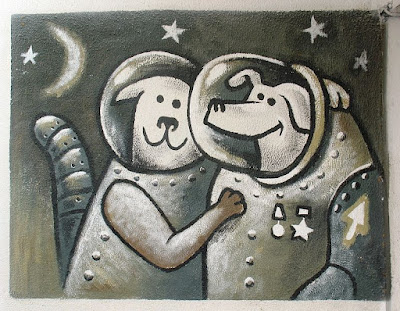Little did I think when I saw Alan’s photo this week of a lady perched on a car bumper that I would continue my space theme from last week. I knew I had no bumper photos of my own but then I hit on a series of photos from NASA.
 |
| Bumper Rocket |
In February 1949 a high altitude test vehicle was launched. Called Bumper WAC it became the first recorded man-made object to reach extraterrestrial space at a record altitude of 250 miles. This record was held until 1957.
The first stage of the Bumper WAC was a German V-2, the warhead replaced by a launching compartment. The photo shows the second stage, a modified WAC Corporal rocket mounted in the nose cone. Bumper WAC was the world’s first large two-stage liquid propelled rocket.
 |
| Launch of Bumper 8 |
Bumper rockets carried small payloads that allowed them to measure conditions such as air temperature and cosmic ray impact. Bumper 7 and Bumper 8 were used for early studies of the earth’s upper atmosphere.
In 1957 the Soviet Union launched Sputnik I and II the first satellites in earth orbit; the US created NASA in 1958. The rest is history.
Nature has its own bumpers in space.
 |
| Galactic 'Bumper Cars' |
|
(by NASA, William C Keel, University of Alabama, Tuscaloosa.)
This picture, taken by NASA's Hubble Space telescope reveals an intergalactic "pipeline" of material flowing between two battered galaxies that bumped into each other about 100 million years ago.
Astronomers expect more fireworks to come. The galaxies are doomed to continue their game of "bumper cars," hitting each other and moving apart several times until finally merging in another 200 million years. The galaxies are situated about 300 million light-years from earth in the constellation Taurus.
My final picture from space shows how galaxies go wild. Astronomers study how gravity choreographs their motion in the game of celestial bumper cars
 |
| Galaxies gone wild. |
|
(by NASA/ESA, The Hubble Heritage - ESA/Hubble Collaboration, and A Evan, University of Virginia, Charlottesville/NRAO/Stony Brook University)
If you have not enjoyed this post then I suppose I shall have to scrap the bumpers and add them to this pile.
 |
| Scrapped car bumpers, Wharf Street, Warwick |
(geograph.org.uk:by Robin Stott; Creative Commons Attribution-Share Alike 2.0 Generic License)
Alan's photo at
Sepia Saturday 85 was the lady at Warwick Farm Racecourse so I maintained a 'Warwick' connection. Check it out there for more bumper fun














































